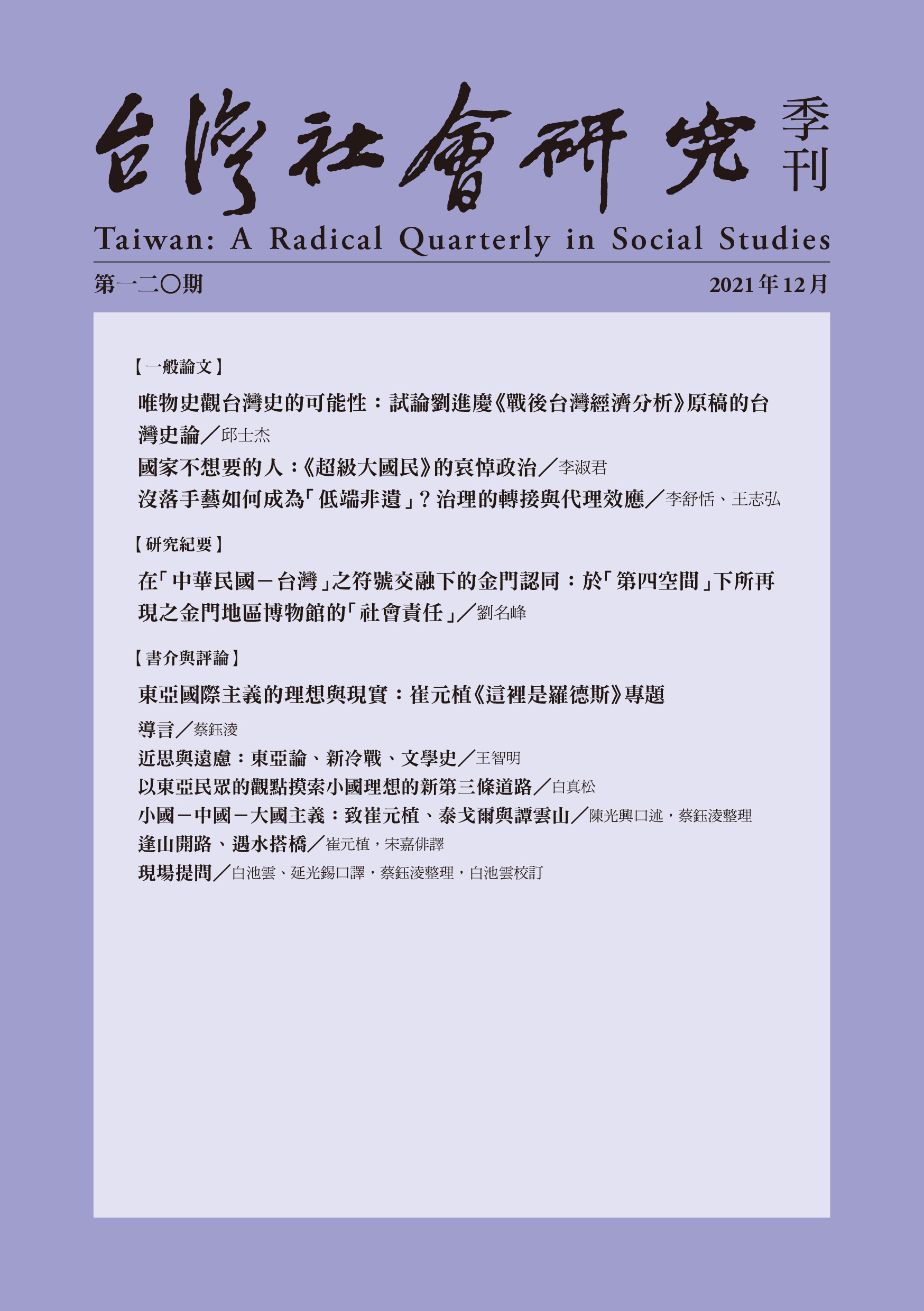
《台灣社會研究季刊》 第120期:
【一般論文】
唯物史觀台灣史的可能性:試論劉進慶《戰後台灣經濟分析》原稿的台灣史論/邱士杰(120民110.12 頁1-37)
劉進慶《戰後台灣經濟分析》是以戰後二十年台灣經濟為研究對象的名著,但其原稿即提交給東京大學的博士論文卻與正式出版者頗有差異。原稿保留了他以相當篇幅分析近世(Early Modern)晚明到戰後二十年的台灣歷史敘述,並以「半封建性」、「殖民地性」,以及資本主義等切入點,開展唯物史觀式的台灣歷史分期。他認為台灣自近世晚明以來就具有某種殖民地性與半封建性:前者根源於持續不斷的移民,後者則根源於漢人社會的封建性向半封建性的自主演化。然而近代(Modern)晚清卻開啟了另一種殖民地性與半封建性,並持續到戰後二十年:近代的殖民地性存在於二重經濟,即外來資本主義與本土半封建性之間的並存,近代的半封建性則因外國資本主義的支配與保存而失去自主演化能力。由於劉進慶試圖以上述解釋作為台灣在戰後二十年仍是殖民地性.半封建性社會的歷史背景,導致其原稿的歷史解釋與戰後台灣優異的經濟表現相當扞格,並促使正式出版的《戰後台灣經濟分析》努力淡化原稿的近世歷史分析以淡化半封建性。雖其淡化成效有限,未盡之處卻為1980年代及其後的劉進慶留下長期回應的課題,並為唯物史觀可否應用於台灣史留下實驗的印記。
關鍵詞:唯物史觀、半封建性、殖民地性、資本主義、台灣歷史
Liu Shinkei (Liu Jinqing)’s Analysis of Taiwan’s Post-War Economy is a famous work explaining Taiwan’s economy in the two decades after the war, but its manuscript, the doctoral dissertation submitted to the University of Tokyo, is quite different from the version officially published in 1975. The manuscript retains his narration of Early Modern (Kinsei) history of Taiwan, and uses “semi-feudality”(han-houkensei), “coloniality”(syokumintisei), and “capitalism” and other historical materialistic concepts to divide “Taiwan History” into different historical stages. He believes that Taiwan has been “colonial” and “semi-feudal” since Early Modern: “coloniality” is rooted in continuous immigration, and “semi-feudality” is rooted in the autonomous evolution of Han society from “feudality” to “semi-feudality.” However, Modern (Kindai) created another type of “semi-feudality” and “semi-feudality”, which lasted until 1965. Liu Shinkei’s characterization of Taiwan in the two decades after WWII as still a “colonial-semifeudal society” in his original 1972 manuscript could not explain Taiwan’s excellent economic performance after the war. Therefore, he rewrote the 1975 version of Analysis of Taiwan’s Post-War Economy with great effort in an attempt to downplay various arguments and concepts that had over-emphasized the premodern characteristics. While the 1975 rewrite as limited in achieving this goal, the unresolved intellectual tasks had guided Liu Shinkei’s work in the 1980s and beyond. In addition, this body of work has also left an important historical benchmark for its experimental attempt to apply historical materialism to the history of Taiwan.
Keywords: historical materialism, semi-feudality, coloniality, capitalism, history of Taiwan
國家不想要的人:《超級大國民》的哀悼政治/李淑君(120民110.12 頁39-80)
本文以導演萬仁的作品《超級大國民》為對象,探討政治受難的不可哀悼與哀悼完成。前行研究已指出1949年國民黨遷台後,台灣被納入國共內戰的「戰爭之框」中,形成「共產集團」vs.「自由民主陣營」的框架,區分「愛國之士」與「共匪嫌疑人」的差異生命。本文分成「不可哀悼的場景」與「心頭的兩座墳:尋墳、哀悼與贖罪」兩部份討論不可哀悼性與哀悼的追尋。首先,「國家不想要的人」的死亡與創傷成為不值得哀悼的一方。其次,政治受難者的獨白、瘋癲、凋零、顧左右而言他,以及國家剷除「記憶所繫之處」使得哀悼更顯艱難。其三,哀悼的重要性在於理解我與他者之間的相互連結、相互依存、相互聯繫。《超級大國民》以祭祀六張犁的亂葬崗、受難家屬的骨灰、第二代的創傷賦予哀悼意義,強調活著的人必須哀悼才能釋懷;死去的人必須成為被哀悼主體才能被記憶。
關鍵詞:萬仁、《超級大國民》、哀悼、白色恐怖、戰爭之框
This paper focuses on film director Wan Jen’s Super Citizen Ko to explore the unmournable political suffering and the completion of its mourning. Previous researches have pointed out that after the Kuomingtang retreated to Taiwan in 1949, Taiwan became trapped in the frame of the conflict between the “communists” and the “liberal democrats” in the Chinese Civil War, and the “patriots” were differentiated from suspected “communist spies.” The unmournable nature of political suffering and the search for mourning are discussed in two parts, namely “Unmournable Scene” and “Two Graves in the Heart: Grave-Seeking, Mourning, and Atonement.” First, the death and wounds of the people unwanted by the nation became unmournable. Second, the monologues, madness, and withering of political victims, along with their evasion of subjects and the erasure of the places of their memories by the nation, has further increased the difficulty of mourning. Third, the value of mourning lies in understanding the connection and interdependence between oneself and others. Super Citizen Ko grants meanings to mourning through the worshipping of the unmarked graves in Liuzhangli, the ashes of the victims’ families, and wounds of the second generation, stressing the inevitability of mourning in the process of relieving sadness. Political victims who have lost their lives can be remembered only if they are the subjects of mourning.
Keywords: Wan-Jen, Super Citizen Ko, mourning, white terror, frame of war
沒落手藝如何成為「低端非遺」?治理的轉接與代理效應/李舒恬、王志弘(120民110.12 頁81-133)
本文基於批判性遺產研究觀點,檢視中國發展脈絡下,非物質文化遺產保存政策與宣傳措施的侷限。沒落的傳統手工技藝通常必須改採機械化生產,或是接軌觀光旅遊產業,方能以某種變貌存續。非物質文化遺產提供了另一種保存傳統工藝的框架,並鑲嵌於因應都市轉型和競爭的文化治理脈絡。然而,「非遺」提供的文化正當性往往必須服膺遺產治理的政績要求,這又緊繫於品牌化與行銷策略,並委由擔任文化中介者的專業團隊操作。於是,傳統技藝的遺產治理具有將傳統轉接於文化商品市場,並以專家來代理的效應。作者以廣東東莞萬江新村地區的手工腐竹為例,採取參與式觀察及訪談方法,探討遺產治理的轉接與代理效應,如何令傳統工藝以非遺之名振興,卻又墮入了低端位置。
關鍵詞:文化治理、文化中介者、後工業轉型、歷史保存、文創產業
Based on the critical heritage studies viewpoint, this article examines the limitations of intangible cultural heritage preservation policies and publicity measures in the context of China’s development. Traditional handicrafts that have fallen into decline usually have to be transformed into mechanized production or integrated into the tourism industry in order to survive in a certain distortion. Intangible cultural heritage provides another framework for preserving traditional crafts, and is embedded in the context of cultural governance in response to urban transformation and competition. However, the cultural legitimacy provided by intangible cultural heritage often has to comply with the performance requirements of heritage governance, which in turn is closely tied to branding and marketing strategies, and is operated by a professional team of cultural intermediaries. Therefore, the heritage governance of traditional skills has the effect of switching the heritage from a tradition to a cultural commodity while making experts as proxy. The authors take the handmade bean-curd sticks in Wanjiang New Village, Dongguan, Guangdong as an example, and adopts participatory observation and interview methods to explore how the switch and proxy effects of heritage governance, while revitalizing traditional crafts in the name of intangible heritage, make the traditional crafts fall into the low-end position.
Keywords: cultural governance, cultural intermediary, post-industrial transition, historical preservation, cultural-creative industries
【研究紀要】
在「中華民國-台灣」之符號交融下的金門認同:於「第四空間」下所再現之金門地區博物館的「社會責任」/劉名峰(120民110.12 頁135-183)
中華民國與台灣兩種對象的認同與其間的緊張,在當下台灣社會是關鍵的問題。本文以金門地區的博物館為研究的對象,即是以地緣及歷史上與本島台灣相當不同、並特別強調中華民國認同的金門,了解「中華民國-台灣」兩組認同符號間的關係,以及隨之而來所交融的金門認同。並且,為能系統又有效地掌握此間的符號,筆者以金門地區三種主要類型之博物館的展覽,作為本文的研究對象。其次,就此一認同現象的交融,本文從關係主義的存有來建構出「第四空間」,再具體說明其中固然存在著「中華民國-台灣」兩組符號的對比,但此間建構的並非是種實體,而是互為內在他者地相倚,並參照著總體的群體關係。如此一來,不僅在博物館之展覽的集體再現裡會出現兩種認同符號的交融,它們還在民主轉型期間益加緊密。再者,交融的發生及內容同時受到博物館之性質及其所處之制度形態的不同而有差異。以中國大陸為外在他者的戰地博物館,與向海外串聯的僑鄉博物館,大部分由內政部所屬之金門國家公園管轄,其所再現之符號的交融,較由金門縣府所主管、向中國大陸延伸之閩南文化類型之博物館為高。最後,不管是哪一種類型的博物館,金門所在的空間都因地緣及歷史文化上的特殊性,在民主轉型之「台灣化」的過程中成為較邊陲的角色,但它所再現之「中華民國台灣」的認同形式,卻正是當下台灣主流的認同論述。因此,在此間博物館中所集體再現的認同形式,即以其特殊的邊陲性,於「中華民國-台灣」的交融之間,實踐了當下台灣的社會責任,也就是在多元與差異之間,提醒著總體性的價值。
關鍵詞: 博物館、社會責任、關係主義、第四空間、交融
The question of identity is critical in Taiwan, while the case of Kinmen plays a special role in this regard because of its geo-historical position. As such, this research elaborates a relational perspective to study the representation of its three main types of museums, which are the minan (閩南), battlefield (戰地), and qiaoxiang (僑鄉), and to demonstrate the communitas of Kinmen’s identity. These museums are constructed mostly in the course of democratization, within which the symbolic struggle between Republic of China and Taiwan plays a central role, and leads to the construction of Kinmen’s identity. In other words, Kinmen’s identity is constructed vis-à-vis Taiwan on the one hand, and represents the communitas of “ROC-Taiwan” on the other. This is because Kinmen not only takes Taiwan as internal Other, but also intertwines itself with Taiwan in the construction of an imagined community, named “ROC-Taiwan”, which is the mainstream discourse of national identity of the present time. Yet, Kinmen’s museums demonstrate much more abundantly the image of the “ROC-Taiwan” among others, with their respective configurations. As a result, these museums represent Kinmen’s local identity and nation identity at the same time. Thus, the concept of fourthspace is capable of demonstrating the elaboration of identity in Kinmen. Moreover, the representation of the three types of museums manifests soundly the fact that the existence of Kinmen itself realizes the idea of social responsibility since it leads not only to the social inclusion and plurality, but also and more importantly to the reminder of “ROC-Taiwan” as a whole.
Keywords: museums, social responsibility, relational ontology, fourthspace, communitas
【書介與評論】
東亞國際主義的理想與現實:崔元植《這裡是羅德斯》專題
導言/蔡鈺淩(120民110.12 頁185-187)
近思與遠慮:東亞論、新冷戰、文學史/王智明(120民110.12 頁189-195)
以東亞民眾的觀點摸索小國理想的新第三條道路/白真松(120民110.12 頁197-209)
小國-中國-大國主義:致崔元植、泰戈爾與譚雲山/陳光興口述,蔡鈺淩整理(120民110.12 頁211-217)
逢山開路、遇水搭橋/崔元植,宋嘉俳譯(120民110.12 頁219-225)
現場提問/白池雲、延光錫口譯,蔡鈺淩整理,白池雲校訂(120民110.12 頁227-234)


